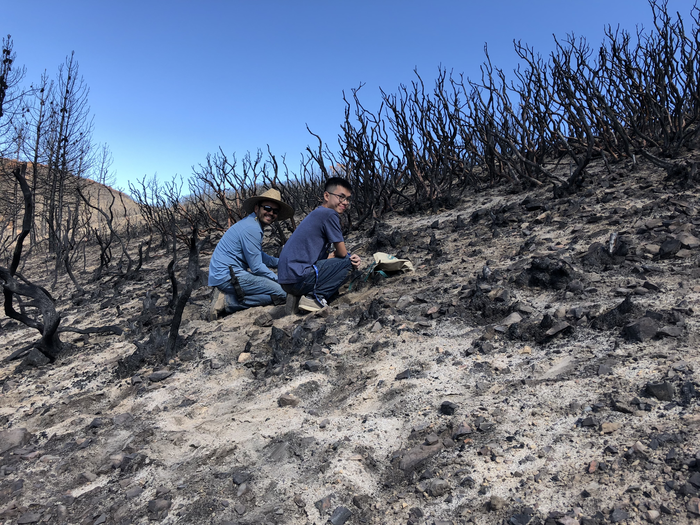Scientists have found microbes living in the charred soil that wildfires leave behind. They don’t know how some fungi and bacteria manage to thrive when everything else has died, but a new project aims to change that.

Credit: Sydney Glassman/UCR
Scientists have found microbes living in the charred soil that wildfires leave behind. They don’t know how some fungi and bacteria manage to thrive when everything else has died, but a new project aims to change that.
UC Riverside scientists will spend the next three years studying the traits that allow soil microbes to respond to fire, as well as the role those microbes play in storing or emitting powerful greenhouse gases like carbon dioxide or nitrous oxide.
The work is funded by an $849,000 grant from the U.S. Department of Agriculture’s National Institute of Food and Agriculture.
“There’s very little known about which microbes respond to fires, or why, or what effect they have on the rest of the environment,” said UCR mycologist Sydney Glassman. “We want to know how the fungi and bacteria that remain impact greenhouse gas emissions from post-fire soils.”
To answer their questions, Glassman and UCR environmental scientist Pete Homyak are sampling soil from two major, nearby burn scars— 2018’s Holy Fire in Orange and Riverside counties, and 2020’s El Dorado Fire, also known as the “Gender Reveal Fire” in San Bernardino County.
They’ll test whether remaining microbes have traits resembling ones found in plants that can flourish after fires.
One such trait is the ability to reproduce quickly. “After a burn, there’s a lot of space that opens up. If they reproduce asexually, they can multiply at a particularly rapid speed and colonize that space,” Glassman said.
A second quality is the ability to ‘feed’ on burnt things. Fire turns trees into charcoal, leaf matter into waxes, and releases large amounts of nitrogen. Most microbes don’t prefer high levels of nitrogen. However, the researchers believe it’s possible a select few do feast on a diet of charcoal or nitrogen, or wax.
Additionally, there are some plants that can simply tolerate high heat. Microbes could be the same. “There is some evidence of spores that are thermotolerant, or even require heat to reproduce,” Glassman said.
Future projects will look not only at the characteristics of post-fire microbes, but at whether adding pre-fire fungi and bacteria back into soils could help with recovery.
In a separate but related study, members of the group are trying to characterize the effects of flame retardants that are regularly added to vast tracts of forest land. Some of these chemicals deposit phosphorus and nitrogen that lasts for decades. The impact of that on naturally occurring microbes is also still unclear.
“Fires have really strong impacts on soil chemistry, and the main things mediating those impacts are the microbes,” Glassman said. “The ones that survive transform the carbon and nitrogen left behind, setting the stage for regeneration. That’s why we think they’re so important to understand.”




